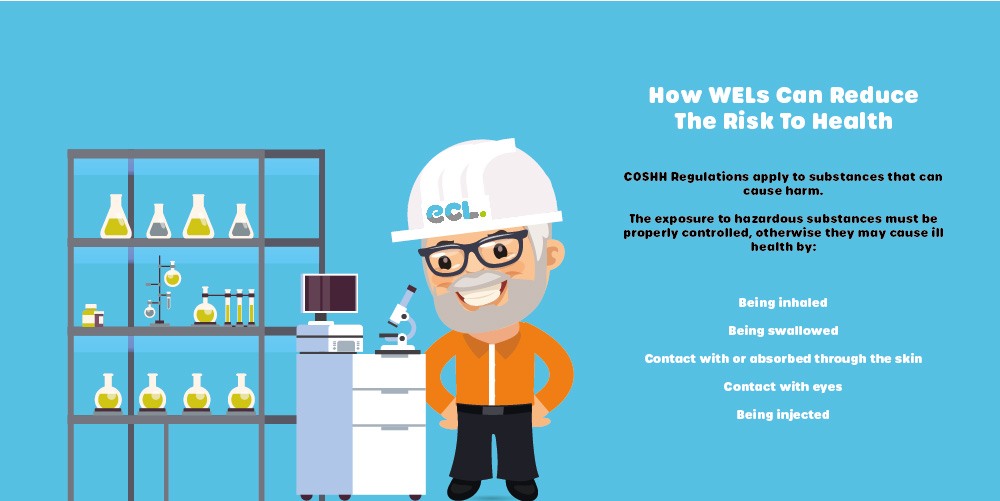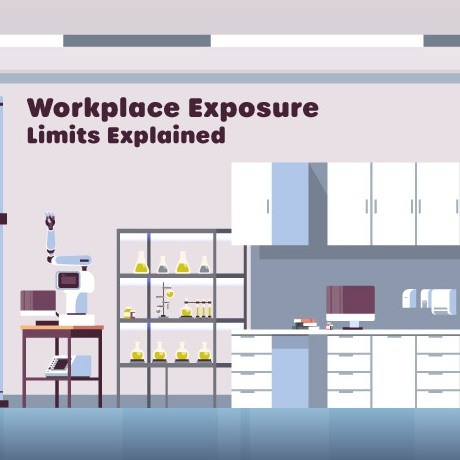What Are Workplace Exposure Limits?
Workplace exposure limits (WELS) are limits set under COSHH Regulations in order to help protect the health of workers, with almost all industries in the UK regulated by the HSE.
Workplace exposure limits are used to help protect people from hazardous substances, such as chemicals, wood dusts, solvents, Welding Fumes to name a few. It is especially important as some substance’s effects may not appear until many years after exposure.
In order to meet regulation and maintain COSHH Compliance, employers are required to ensure no employees, clients, contractors or the public are exposed, by inhalation, to a concentration of any substance in excess of the Occupational Exposure Limits for that specific substance.

What Is A WEL?
A WEL is the maximum concentration of a hazardous substance in the air that people breathe, averaged over a specific period of time, referred to as a time weighted average (TWA). Typically, this is eight hours, but short-term exposure periods of 15 minutes are also assigned limit values.
COSHH Regulations apply to substances that can harm through either skin contact, inhalation, injection, ingestion and contact with eyes.
WELs specifically apply to exposure by inhalation, as for most substances, this is usually the main route of entry into the body.
You can usually find resource and information about relevant workplace exposure limits via a substance’s / product’s Materials Safety Data Sheets (MSDS). MSDS contain technical information such as the composition of the chemical, first-aid measures, handling and storage information and disposal considerations for example.
What Determines the WEL Limits?
- A level where no adverse effects on human health would be expected to occur based on the known and/or predicted effects of the substance.
or
- A Level corresponding to what is considered to represent good control, accounting for the severity of the likely health hazards and the cost and effectiveness of control solutions.
How to Calculate WELs
There are two time periods when calculating exposure for comparison with WELs:
Short Term Exposure Limits (STELs)
- Usually, 15 minutes to control effect that may be seen after a brief exposure
- The STEL exposure limit relates to peak exposure incidents and is designed to protect against immediate acute ill-health effects.
Long Term Exposure Limits (LTELs)
- 8 hours to control effects by restricting the total intake over one or more work shifts
- The LTEL is designed to protect the workforce from concentrations of contaminants, which, over a large period of time, could cause long term chronic ill health effects.
If exposure cannot be prevented, then adequate controls must be implemented. But controls can only be considered adequate if:
- Workplace exposure limits (WEL) have not been exceeded.
- For carcinogens and sensitisers exposure is reduced to as low as reasonably practicable (ALARP)
- Principles of good practice have been applied

What If A Substance Is Not Assigned A WEL?
There are so many chemical compounds and substances used in the workplace but often there isn’t enough safety information present on them, especially that outline accurate occupational exposure limits.
Not all substances used in the workplace have WEL values, but just because a substance doesn’t have a WEL, it doesn’t mean it’s safe.
COSHH Regulations state, exposure should still be controlled to a level which is safe for any hazardous substance to be created or used at work.
You can find out all current workplace exposure limits via the HSE publication EH40 Workplace Exposure Limits. These are revised routinely, with new entries added with each new edition.
Example WELs
Here are a few examples of substances which are hazardous to your health and their WELs:
- Hardwood Dust: 3mg/m3 8hr TWA
- Silica Dust (Respirable Crystalline): 0.1mg/m3 8hr TWA
- Welding fume which consists of different substances (Some below):
- Iron Oxide: 5 mg/m3 8hr TWA
- Manganese (Inhalable): 0.2 mg/m3 8hr TWA
- Chromium: 0.5 mg/m3 8hr TWA
As an employer, if you have hazardous substances in your workplace, it is important that these are controlled adequately. Quantification of exposure, and thus verification as to whether or not adequate control is being achieved, can be carried out by undertaking workplace exposure monitoring, which ECL are able to help you with.
Workplace Exposure Monitoring
The most effective way of understanding if exposure is currently within the workplace exposure limit or not, is by the conducting of workplace exposure monitoring.
Regulation 10 of the COSHH Regulations imposes a duty to monitor the exposure of employees to substances hazardous to health in certain specified situations.
In order to assess exposure levels of airborne substances in the workplace, we can use sampling strategies such as personal / static air sampling, which measures the hazardous substance within the breathing zone of the worker or surrounding workplace air.
This is executed by fitting portable air samplers to employees which draw air through a sorbent tube / filter, which can subsequently be analysed in a laboratory for contaminants known to be used in that particular process, in order to determine personal exposure. Where exposure to unknown contaminants is concerned, similar techniques may be employed in an attempt to identify then quantify any / all exposure.
Current working practices should then be thoroughly assessed, and safety measures and control strategies improved where possible, with the aim of preventing or, at the very least, reducing exposure to hazardous substances.
This could be achieved with engineering control measures like Local Exhaust Ventilation Testing or PPE, (which should always be a last means of exposure reduction).
Workplace Exposure Monitoring should be carried out when a process changes, when new materials are introduced, a new plant is installed, or when a new or revised WEL is released for relevant substances used within your process. Routine, periodic monitoring may also be required / recommended depending upon the results of any initial sampling / exposure assessment.
Your Workplace Exposure Limits Experts
ECL has numerous years of experience providing workplace air monitoring services to companies in the UK and around the world.
All ECL occupational hygiene services demonstrate compliance with Health & Safety best practice. ECL is competent to deliver an accurate, dependable, unbiased and fair service with:
- The preparation of COSHH Risk Assessments.
- Monitoring exposure measurements and assessments for various substances.
- Assessment and evaluation of the effectiveness of control measures.
- Local Exhaust Ventilation Testing.
Call us on 01443 841760 or fill out our Enquiry Form for any queries regarding Workplace Exposure Limits, COSHH Air Monitoring, Stack Emissions Monitoring, Workplace Noise Assessments or any of our many other Environmental and Occupational Hygiene services.

